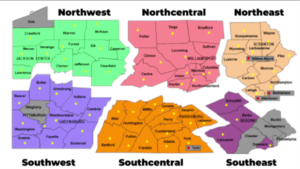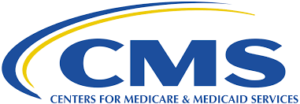COVID-19 update for Friday, May 1 as of 4:00 p.m.
Pennsylvania Update
Reopening Pennsylvania
 Governor Wolf on Friday announced the reopening of 24 Pennsylvania counties in the northwestern and north-central parts of the state, moving them from red to yellow in his three-color plan for reopening the state. The governor outlined the criteria used to reach these decisions and the provisions for contact tracing and additional testing that make reopening possible. The reopening calls for reduced use but not elimination of social distancing and includes guidance on work, congregate, and social activities that are now permitted as well as those that remain restricted or prohibited. On Monday the administration will release guidance for businesses permitted to reopen in the selected counties.
Governor Wolf on Friday announced the reopening of 24 Pennsylvania counties in the northwestern and north-central parts of the state, moving them from red to yellow in his three-color plan for reopening the state. The governor outlined the criteria used to reach these decisions and the provisions for contact tracing and additional testing that make reopening possible. The reopening calls for reduced use but not elimination of social distancing and includes guidance on work, congregate, and social activities that are now permitted as well as those that remain restricted or prohibited. On Monday the administration will release guidance for businesses permitted to reopen in the selected counties.
Health Secretary Levine encouraged residents of the 24 counties to continue the recent practices of social distancing and use of face masks. For more information on the reopening, what it means, and how it will work, see this news release from the governor’s office. Additional resources of interest include:
- the risk-based decision support tool developed by Carnegie Mellon University that was used to help guide decision-making on which regions and counties to reopen;
- a state document on contact tracing;
- a state document on COVID-19 testing; and
- the standards the state is employing when making reopening decisions.
 Department of Health
Department of Health
The Department of Health has updated its interim guidance for collecting clinical specimens for COVID-19 testing.
Department of Health Daily Briefing
- Governor Wolf and Secretary Levine discussed the reopening of 24 counties during the daily briefing.
- The governor said that southwestern and south-central Pennsylvania look like good candidates for reopening in the near future.
- Secretary Levine discussed how contact tracing would be undertaken in the 24 counties, listing the resources that would be involved and holding out the possibility that the state may hire additional people to help, if needed.
- Community-based testing will be available in the 24 counties for people with COVID-19 symptoms.
- The governor said the state has already reduced spending in the current fiscal year in light of reduced revenue and that he will be working with the legislature on an FY 2021 budget with the understanding that revenues will continue to be down from past levels.
- 2677 people are currently hospitalized with COVID-19 and 561 of them have required help from a ventilator.
- 40 percent of the state’s acute-care beds and 47 percent of its ICU beds are currently unoccupied and 70 percent of ventilators are now idle.
Department of Human Services
DHS has posted information about all-patient refined-diagnosis related groups (APR-DRGs) to be updated with COVID-19 billing codes.
Department of Revenue
The Revenue Department announced that Pennsylvania collected $2.2 billion in General Fund revenue in April, which was $2.2 billion, or 49.7 percent, less than anticipated. For the fiscal year-to-date General Fund collections total $27.5 billion, which is $2.2 billion, or 7.4 percent, below estimate. It is too soon to draw any conclusions about how this will affect negotiations for the state’s FY 2021 budget and its Medicaid program but this loss of revenue clearly poses a challenge state officials will need to address.
Federal Update
Follow-Up to Thursday’s Interim Final Rule Release
 Yesterday CMS released a second interim final rule with comment period announcing a new round of regulatory waivers and rule changes to provide additional flexibility to the health care system as the COVID-19 crisis continues and the country begins to reopen.
Yesterday CMS released a second interim final rule with comment period announcing a new round of regulatory waivers and rule changes to provide additional flexibility to the health care system as the COVID-19 crisis continues and the country begins to reopen.
These changes included some of the telehealth flexibilities providers have asked for in recent weeks, such as hospital reimbursement for the originating site when telehealth services for Medicare patients are furnished by a physician or practitioner who ordinarily practices in a hospital outpatient department to a patient who is located at home or other applicable temporary expansion location that has been made provider-based to the hospital; an expanded list of telehealth codes that may be offered with audio-only technology; and an expanded list of professionals who may bill for telehealth visits. CMS has also increased reimbursement for three of the audio-only evaluation and management telehealth services described with codes 99441-99443.
Teaching hospitals are permitted to expand their number of beds without affecting indirect medical education (IME) bed ratios; to count the time of residents sent to other hospitals; and to permit teaching physicians to remotely review services provided by residents immediately after a patient visit.
The interim final rule implements sweeping changes for many provider types. CMS has updated its provider-specific fact sheets to include this new information. Please let us know if you have any questions that are not answered in the fact sheets.
- Home Health Agencies
- Physicians and Other Practitioners
- Ambulances
- Hospitals
- Teaching Hospitals, Teaching Physicians and Medical Residents
- Long Term Care Facilities (Skilled Nursing Facilities and/or Nursing Facilities)
- Hospices
- Inpatient Rehabilitation Facilities
- Long Term Care Hospitals & Extended Neoplastic Disease Care Hospitals
- Rural Health Clinics (RHCs) and Federally Qualified Health Centers (FQHCs)
- Laboratories
- End Stage Renal Disease (ESRD) Facilities
- Durable Medical Equipment
- Participants in the Medicare Diabetes Prevention Program
- Medicare Advantage and Part D Plans
- State Medicaid & Basic Health Programs
- Medicare Shared Savings Program Participants
Centers for Medicare & Medicaid Services
- The White House announced that CMS will be distributing $12 billion of CARES Act provider relief to 395 hospitals that have cared for 70 percent of the diagnosed COVID-19 cases. The majority of the funds will go to providers in New York, New Jersey, and Illinois. $2 billion of this money will go toward a Medicare DSH adjustment for those hospitals. We are still awaiting additional details.
- CMS has announced the creation of an independent commission to conduct a comprehensive assessment of the nursing home response to the COVID-19 emergency. See CMS’s news release and a fact sheet.
- CMS has updated it EMTALA FAQ for hospitals to address COVID-19-related issues.
Department of Health and Human Services
- HHS has launched a new COVID-19 Uninsured Program Portal, which will be the vehicle through which providers seek reimbursement for the COVID-19-related services they provide to uninsured patients. HHS has now released a companion billing guide with more detailed information about the process for electronic data interchange (EDI) claims submission. Providers are encouraged to sign up as quickly as possible to avoid processing delays.
- HHS’s Office of the Inspector General has updated its FAQ on how it is exercising its discretion in the enforcement of requirements directly connected to the COVID-19 emergency. The FAQ also describes how stakeholders can submit questions about how the OIG is applying its discretionary authority during the pandemic.
Food and Drug Administration
- The FDA has updated its list of authorized ventilators, ventilator tubing connectors, and ventilator accessories.
- The FDA has issued emergency use authorization for two new COVID-19 detection tests (here and here) and one new COVID-19 serology test.
Department of Labor
- Along with the Treasury Department, the Department of Labor has scheduled for publication in the Federal Register a notice extending certain time frames for COBRA participation during the COVID-19 crisis.
Federal Communications Commission
- The FCC has awarded 13 more grants worth $4.2 million as part of its COVID-19 Telehealth Program for health care providers to provide telehealth services during the COVID-19 emergency.
Medicaid and CHIP Payment and Access Commission
 MACPAC has written to CMS administrator Seema Verma to express its concern that the manner in which her agency is distributing CARES Act funds designated for health care providers is not directing enough of that money to safety-net hospitals and others that care for especially large numbers of Medicaid beneficiaries.
MACPAC has written to CMS administrator Seema Verma to express its concern that the manner in which her agency is distributing CARES Act funds designated for health care providers is not directing enough of that money to safety-net hospitals and others that care for especially large numbers of Medicaid beneficiaries.
Resources to Consult
Pennsylvania Department of Human Services
Pennsylvania Department of Health
Centers for Disease Control and Prevention
(To receive this daily update directly, sign up for our mailing list at info@pasafetynet.org.)